Economics Assignment - Market Analysis and Policy Effects
VerifiedAdded on 2020/06/04
|15
|1797
|266
Homework Assignment
AI Summary
This economics assignment analyzes various market scenarios, including labor markets, and the effects of government policies. Part 1 focuses on labor market equilibrium, minimum wage impacts, and the concept of consumer and producer surplus, using graphical representations to illustrate the concepts. Part 2 delves into price and income elasticity of demand and supply for pocket calculators. Part 3 examines market equilibrium, consumer and producer surplus, and the effects of tariffs in the Australian fig market, considering scenarios with and without tariffs, and the ethical implications of labor practices such as forced labor. The assignment assesses the impact of these policies on various stakeholders, including consumers, producers, and society, along with ethical considerations related to fair labor practices and international trade.
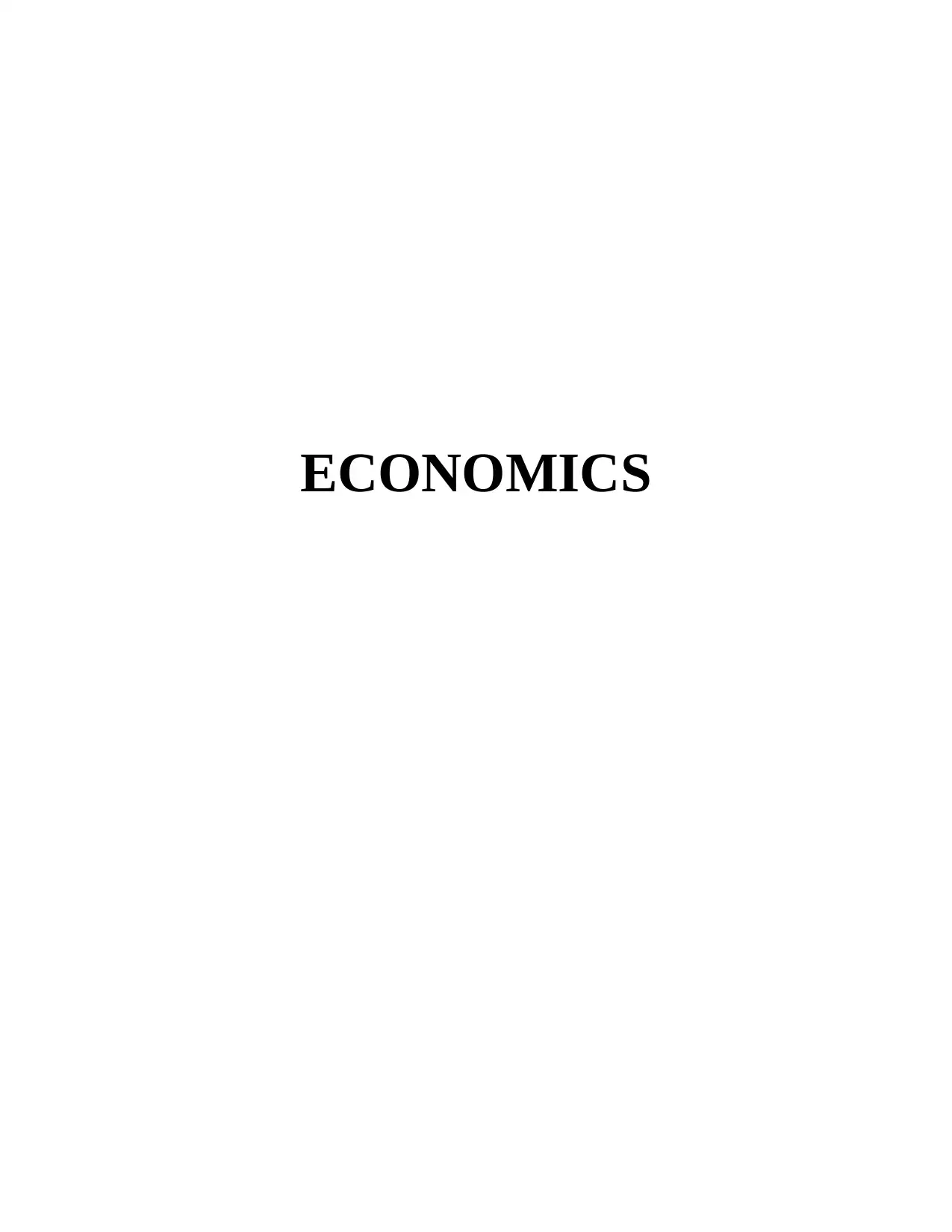
ECONOMICS
Paraphrase This Document
Need a fresh take? Get an instant paraphrase of this document with our AI Paraphraser
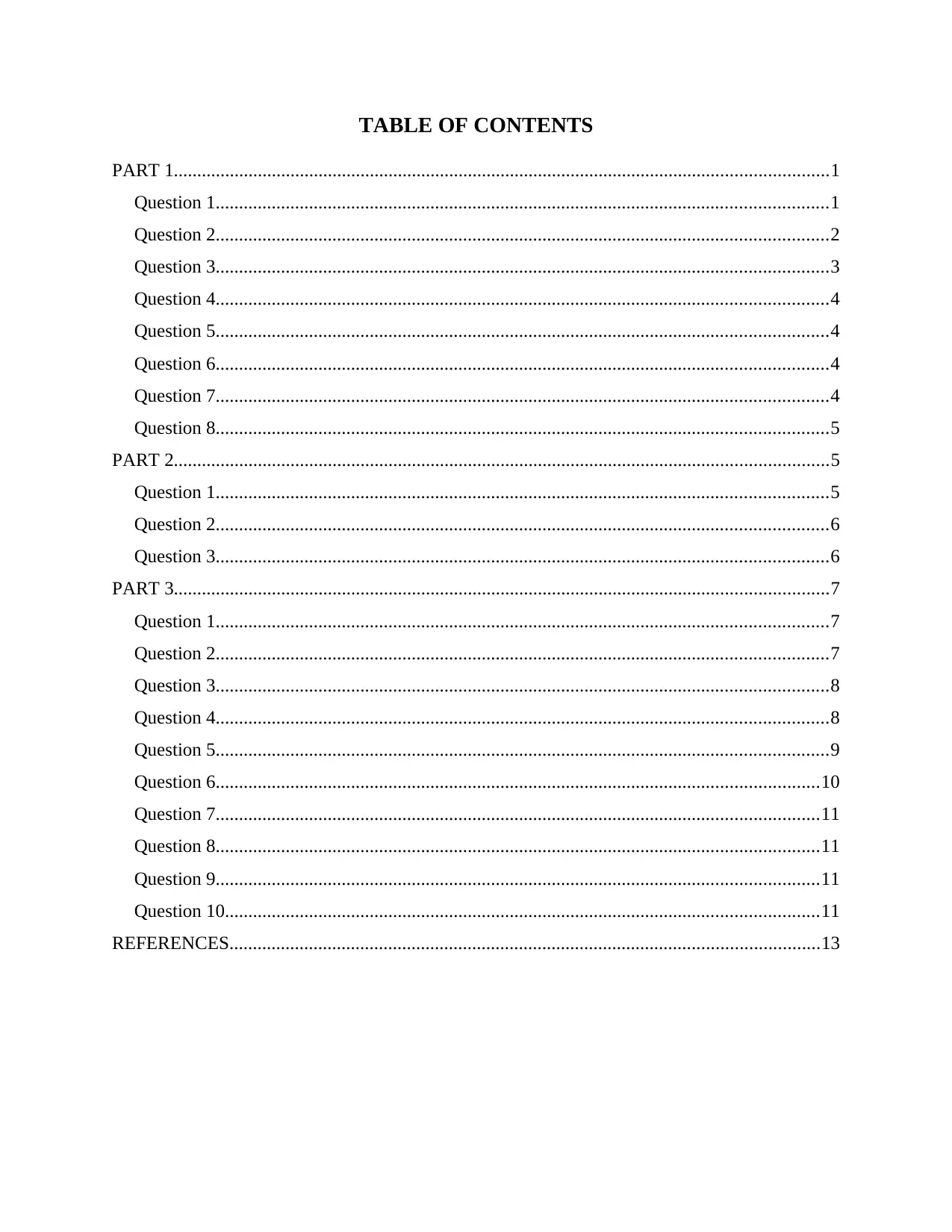
TABLE OF CONTENTS
PART 1............................................................................................................................................1
Question 1...................................................................................................................................1
Question 2...................................................................................................................................2
Question 3...................................................................................................................................3
Question 4...................................................................................................................................4
Question 5...................................................................................................................................4
Question 6...................................................................................................................................4
Question 7...................................................................................................................................4
Question 8...................................................................................................................................5
PART 2............................................................................................................................................5
Question 1...................................................................................................................................5
Question 2...................................................................................................................................6
Question 3...................................................................................................................................6
PART 3............................................................................................................................................7
Question 1...................................................................................................................................7
Question 2...................................................................................................................................7
Question 3...................................................................................................................................8
Question 4...................................................................................................................................8
Question 5...................................................................................................................................9
Question 6.................................................................................................................................10
Question 7.................................................................................................................................11
Question 8.................................................................................................................................11
Question 9.................................................................................................................................11
Question 10...............................................................................................................................11
REFERENCES..............................................................................................................................13
PART 1............................................................................................................................................1
Question 1...................................................................................................................................1
Question 2...................................................................................................................................2
Question 3...................................................................................................................................3
Question 4...................................................................................................................................4
Question 5...................................................................................................................................4
Question 6...................................................................................................................................4
Question 7...................................................................................................................................4
Question 8...................................................................................................................................5
PART 2............................................................................................................................................5
Question 1...................................................................................................................................5
Question 2...................................................................................................................................6
Question 3...................................................................................................................................6
PART 3............................................................................................................................................7
Question 1...................................................................................................................................7
Question 2...................................................................................................................................7
Question 3...................................................................................................................................8
Question 4...................................................................................................................................8
Question 5...................................................................................................................................9
Question 6.................................................................................................................................10
Question 7.................................................................................................................................11
Question 8.................................................................................................................................11
Question 9.................................................................................................................................11
Question 10...............................................................................................................................11
REFERENCES..............................................................................................................................13
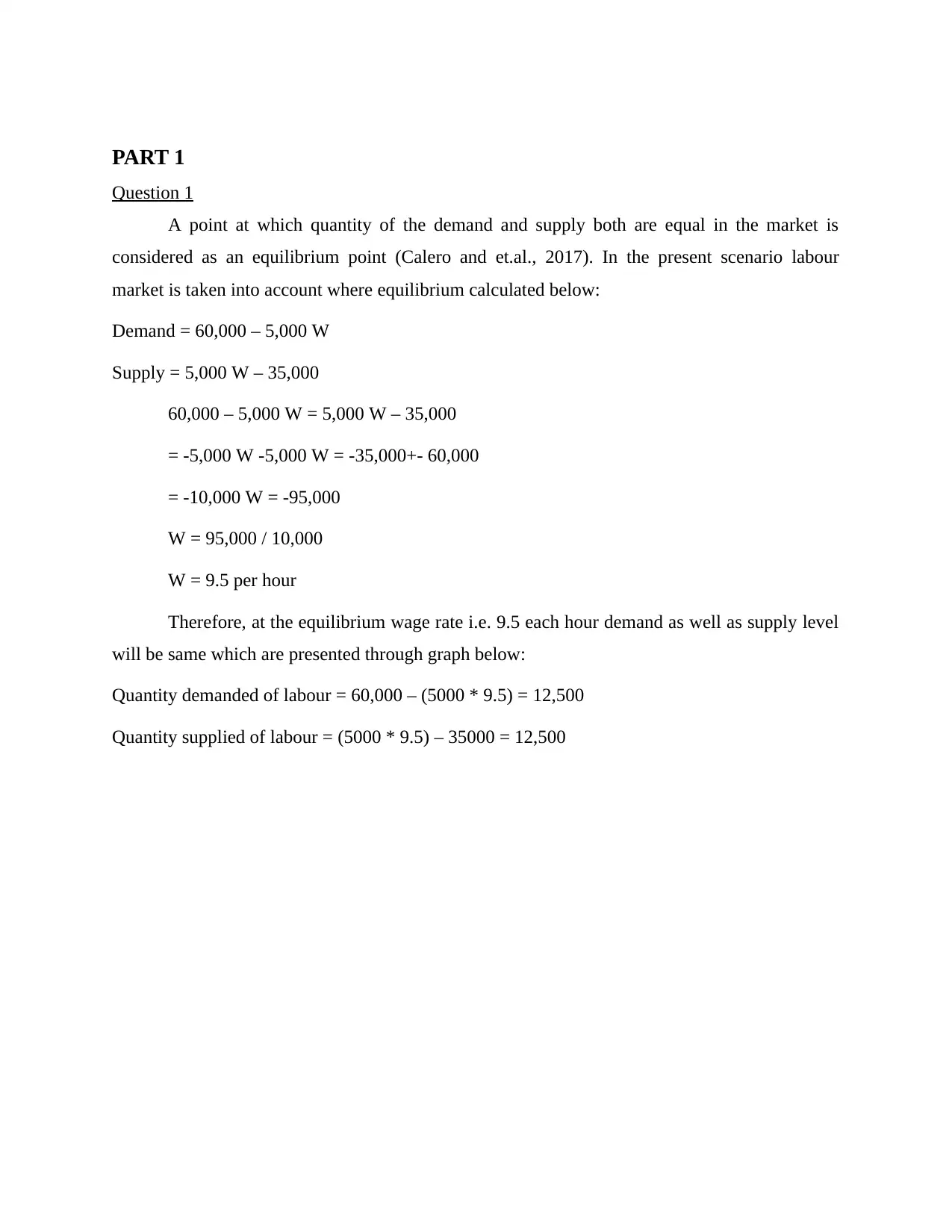
PART 1
Question 1
A point at which quantity of the demand and supply both are equal in the market is
considered as an equilibrium point (Calero and et.al., 2017). In the present scenario labour
market is taken into account where equilibrium calculated below:
Demand = 60,000 – 5,000 W
Supply = 5,000 W – 35,000
60,000 – 5,000 W = 5,000 W – 35,000
= -5,000 W -5,000 W = -35,000+- 60,000
= -10,000 W = -95,000
W = 95,000 / 10,000
W = 9.5 per hour
Therefore, at the equilibrium wage rate i.e. 9.5 each hour demand as well as supply level
will be same which are presented through graph below:
Quantity demanded of labour = 60,000 – (5000 * 9.5) = 12,500
Quantity supplied of labour = (5000 * 9.5) – 35000 = 12,500
Question 1
A point at which quantity of the demand and supply both are equal in the market is
considered as an equilibrium point (Calero and et.al., 2017). In the present scenario labour
market is taken into account where equilibrium calculated below:
Demand = 60,000 – 5,000 W
Supply = 5,000 W – 35,000
60,000 – 5,000 W = 5,000 W – 35,000
= -5,000 W -5,000 W = -35,000+- 60,000
= -10,000 W = -95,000
W = 95,000 / 10,000
W = 9.5 per hour
Therefore, at the equilibrium wage rate i.e. 9.5 each hour demand as well as supply level
will be same which are presented through graph below:
Quantity demanded of labour = 60,000 – (5000 * 9.5) = 12,500
Quantity supplied of labour = (5000 * 9.5) – 35000 = 12,500
⊘ This is a preview!⊘
Do you want full access?
Subscribe today to unlock all pages.

Trusted by 1+ million students worldwide
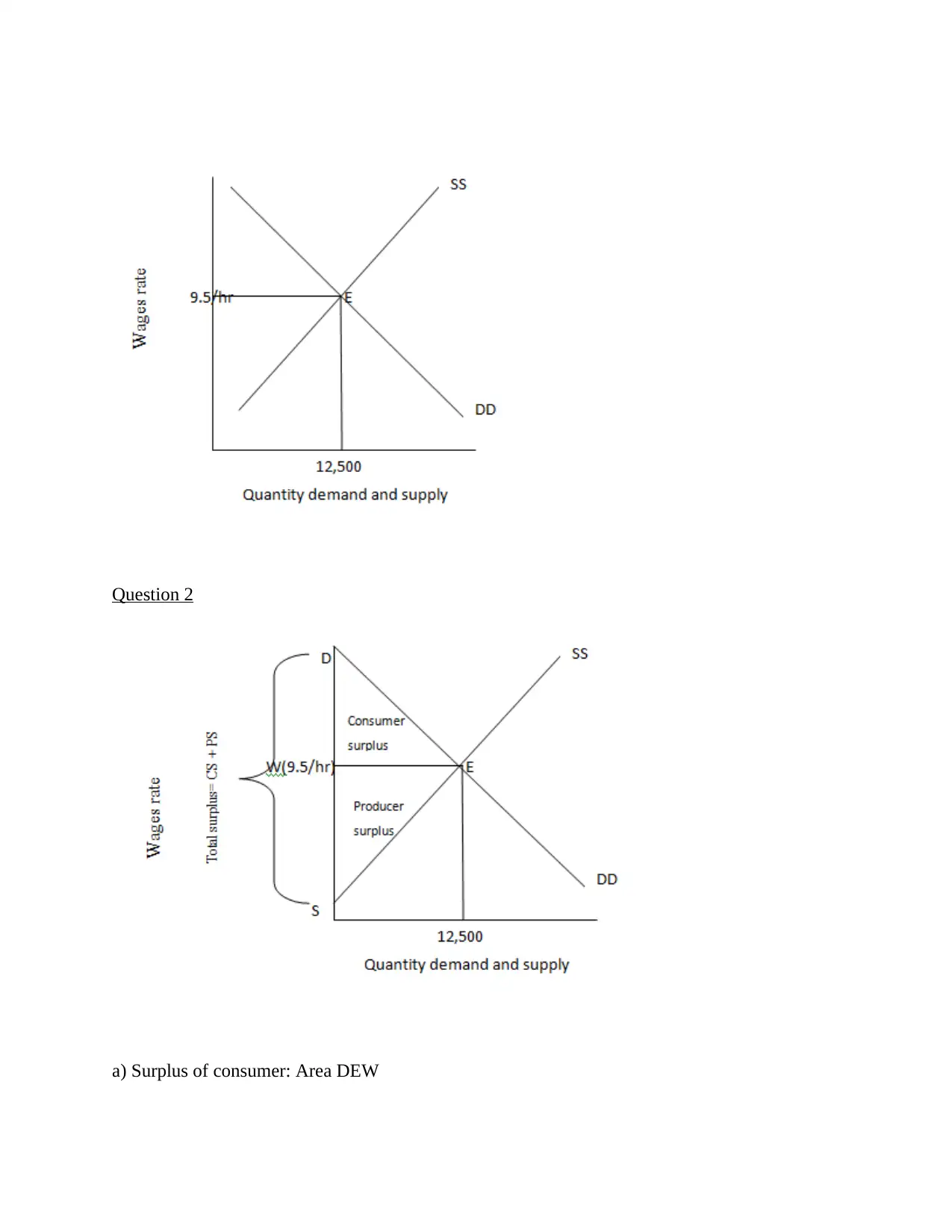
Question 2
a) Surplus of consumer: Area DEW
a) Surplus of consumer: Area DEW
Paraphrase This Document
Need a fresh take? Get an instant paraphrase of this document with our AI Paraphraser
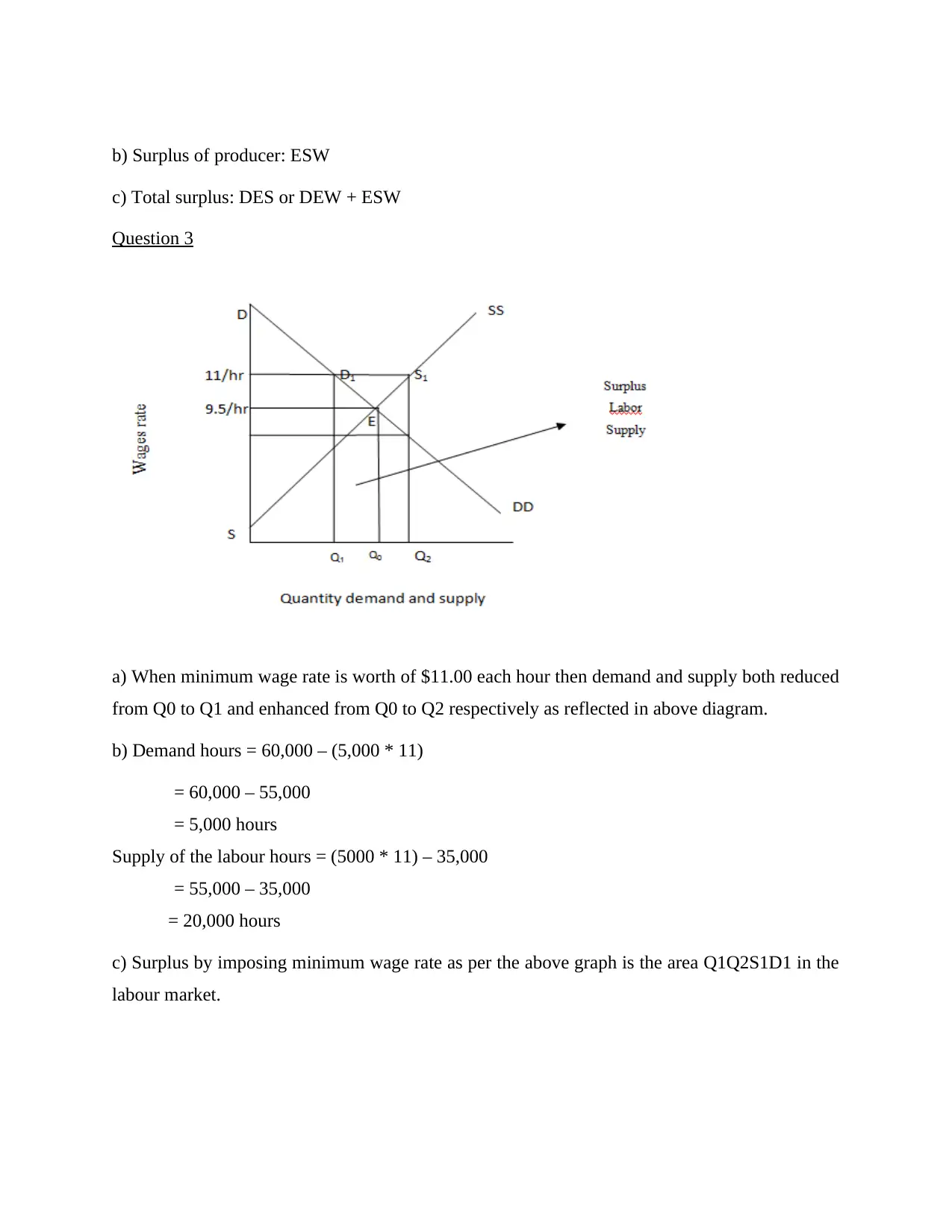
b) Surplus of producer: ESW
c) Total surplus: DES or DEW + ESW
Question 3
a) When minimum wage rate is worth of $11.00 each hour then demand and supply both reduced
from Q0 to Q1 and enhanced from Q0 to Q2 respectively as reflected in above diagram.
b) Demand hours = 60,000 – (5,000 * 11)
= 60,000 – 55,000
= 5,000 hours
Supply of the labour hours = (5000 * 11) – 35,000
= 55,000 – 35,000
= 20,000 hours
c) Surplus by imposing minimum wage rate as per the above graph is the area Q1Q2S1D1 in the
labour market.
c) Total surplus: DES or DEW + ESW
Question 3
a) When minimum wage rate is worth of $11.00 each hour then demand and supply both reduced
from Q0 to Q1 and enhanced from Q0 to Q2 respectively as reflected in above diagram.
b) Demand hours = 60,000 – (5,000 * 11)
= 60,000 – 55,000
= 5,000 hours
Supply of the labour hours = (5000 * 11) – 35,000
= 55,000 – 35,000
= 20,000 hours
c) Surplus by imposing minimum wage rate as per the above graph is the area Q1Q2S1D1 in the
labour market.
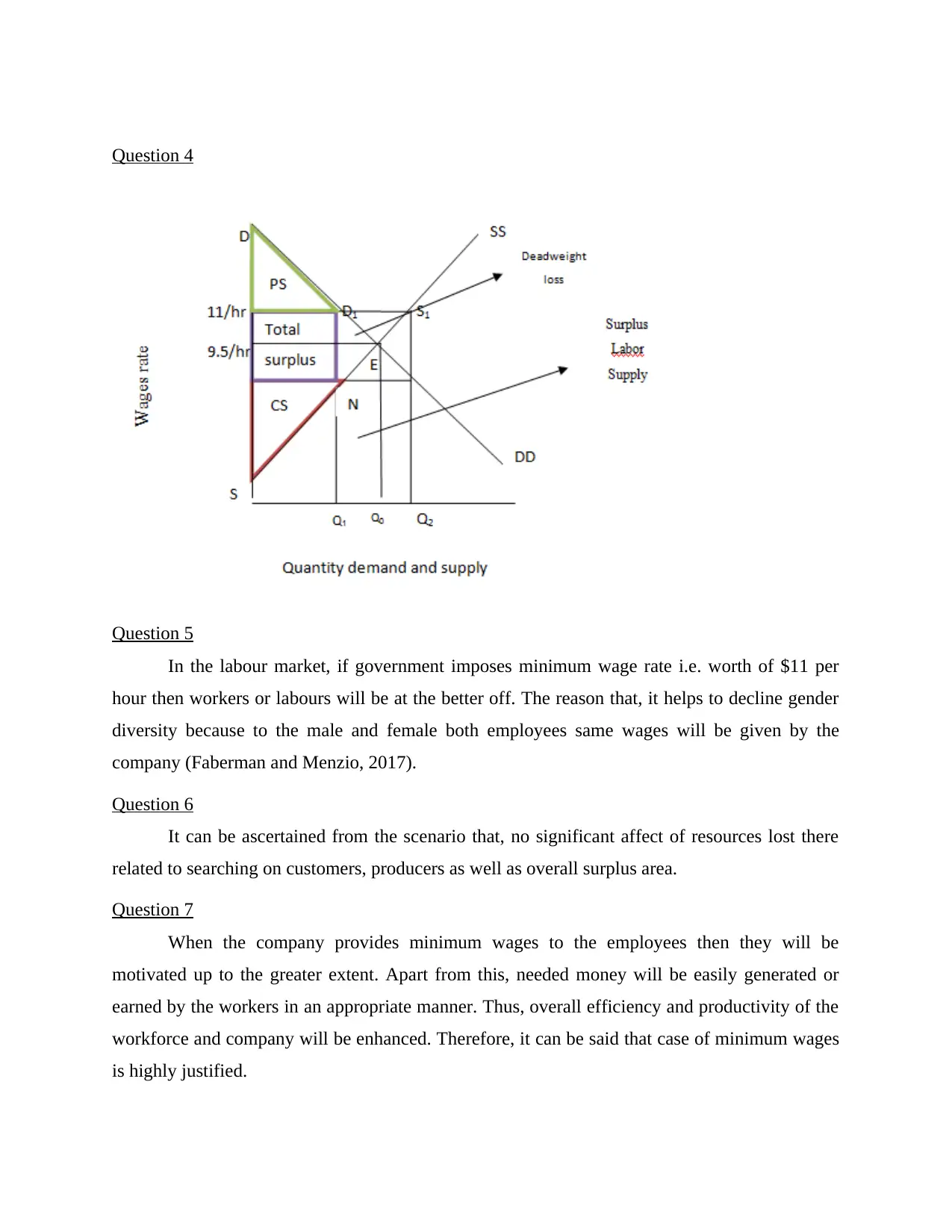
Question 4
Question 5
In the labour market, if government imposes minimum wage rate i.e. worth of $11 per
hour then workers or labours will be at the better off. The reason that, it helps to decline gender
diversity because to the male and female both employees same wages will be given by the
company (Faberman and Menzio, 2017).
Question 6
It can be ascertained from the scenario that, no significant affect of resources lost there
related to searching on customers, producers as well as overall surplus area.
Question 7
When the company provides minimum wages to the employees then they will be
motivated up to the greater extent. Apart from this, needed money will be easily generated or
earned by the workers in an appropriate manner. Thus, overall efficiency and productivity of the
workforce and company will be enhanced. Therefore, it can be said that case of minimum wages
is highly justified.
Question 5
In the labour market, if government imposes minimum wage rate i.e. worth of $11 per
hour then workers or labours will be at the better off. The reason that, it helps to decline gender
diversity because to the male and female both employees same wages will be given by the
company (Faberman and Menzio, 2017).
Question 6
It can be ascertained from the scenario that, no significant affect of resources lost there
related to searching on customers, producers as well as overall surplus area.
Question 7
When the company provides minimum wages to the employees then they will be
motivated up to the greater extent. Apart from this, needed money will be easily generated or
earned by the workers in an appropriate manner. Thus, overall efficiency and productivity of the
workforce and company will be enhanced. Therefore, it can be said that case of minimum wages
is highly justified.
⊘ This is a preview!⊘
Do you want full access?
Subscribe today to unlock all pages.

Trusted by 1+ million students worldwide
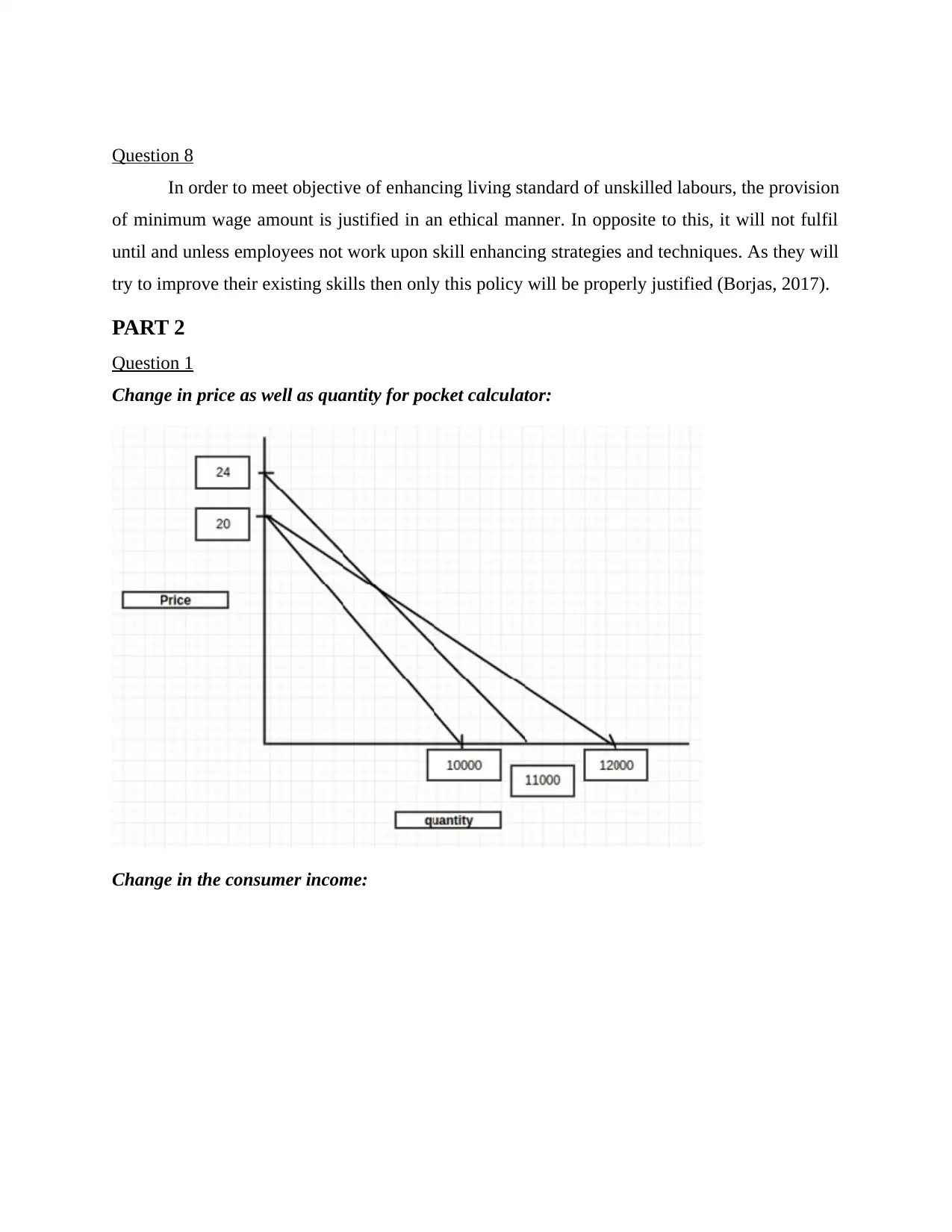
Question 8
In order to meet objective of enhancing living standard of unskilled labours, the provision
of minimum wage amount is justified in an ethical manner. In opposite to this, it will not fulfil
until and unless employees not work upon skill enhancing strategies and techniques. As they will
try to improve their existing skills then only this policy will be properly justified (Borjas, 2017).
PART 2
Question 1
Change in price as well as quantity for pocket calculator:
Change in the consumer income:
In order to meet objective of enhancing living standard of unskilled labours, the provision
of minimum wage amount is justified in an ethical manner. In opposite to this, it will not fulfil
until and unless employees not work upon skill enhancing strategies and techniques. As they will
try to improve their existing skills then only this policy will be properly justified (Borjas, 2017).
PART 2
Question 1
Change in price as well as quantity for pocket calculator:
Change in the consumer income:
Paraphrase This Document
Need a fresh take? Get an instant paraphrase of this document with our AI Paraphraser
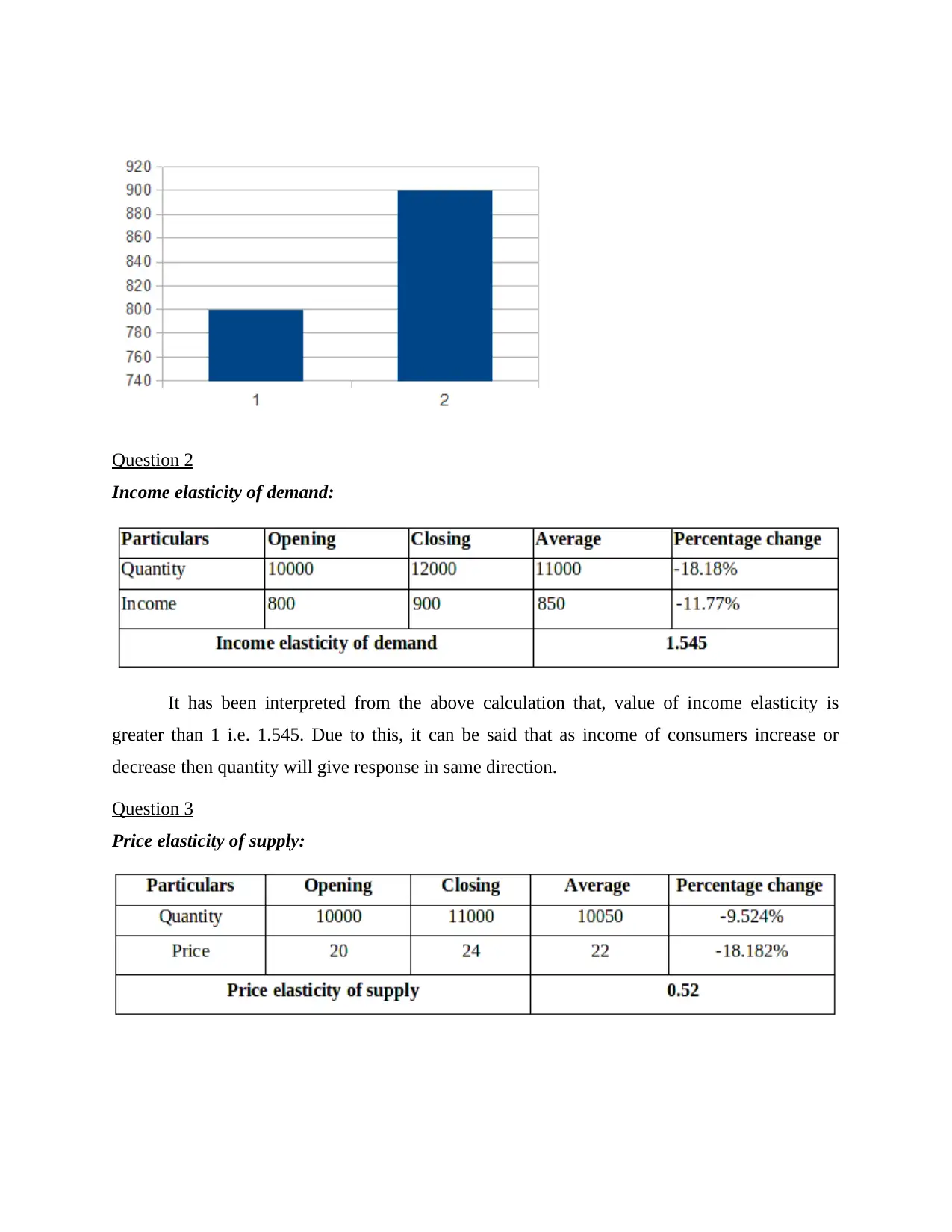
Question 2
Income elasticity of demand:
It has been interpreted from the above calculation that, value of income elasticity is
greater than 1 i.e. 1.545. Due to this, it can be said that as income of consumers increase or
decrease then quantity will give response in same direction.
Question 3
Price elasticity of supply:
Income elasticity of demand:
It has been interpreted from the above calculation that, value of income elasticity is
greater than 1 i.e. 1.545. Due to this, it can be said that as income of consumers increase or
decrease then quantity will give response in same direction.
Question 3
Price elasticity of supply:
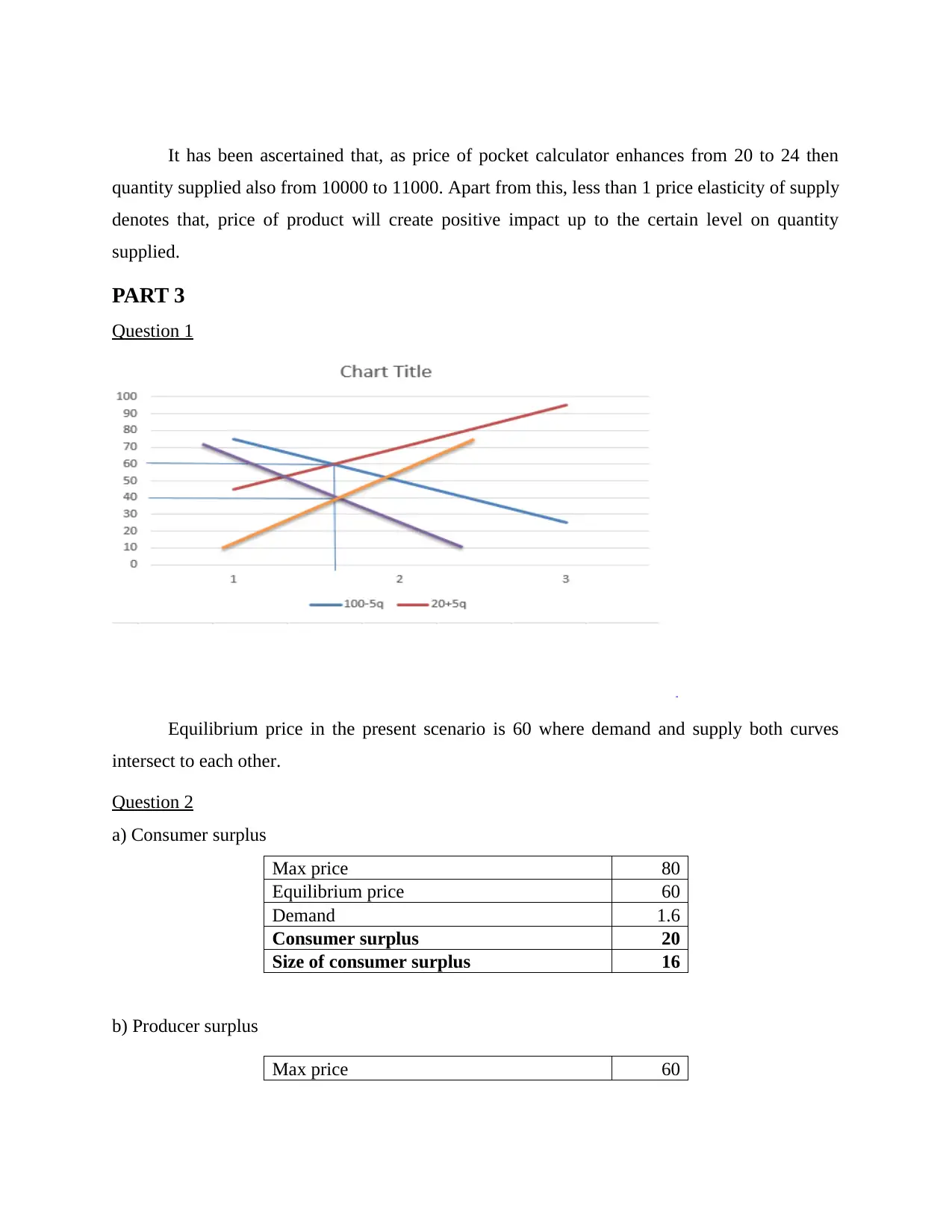
It has been ascertained that, as price of pocket calculator enhances from 20 to 24 then
quantity supplied also from 10000 to 11000. Apart from this, less than 1 price elasticity of supply
denotes that, price of product will create positive impact up to the certain level on quantity
supplied.
PART 3
Question 1
Equilibrium price in the present scenario is 60 where demand and supply both curves
intersect to each other.
Question 2
a) Consumer surplus
Max price 80
Equilibrium price 60
Demand 1.6
Consumer surplus 20
Size of consumer surplus 16
b) Producer surplus
Max price 60
quantity supplied also from 10000 to 11000. Apart from this, less than 1 price elasticity of supply
denotes that, price of product will create positive impact up to the certain level on quantity
supplied.
PART 3
Question 1
Equilibrium price in the present scenario is 60 where demand and supply both curves
intersect to each other.
Question 2
a) Consumer surplus
Max price 80
Equilibrium price 60
Demand 1.6
Consumer surplus 20
Size of consumer surplus 16
b) Producer surplus
Max price 60
⊘ This is a preview!⊘
Do you want full access?
Subscribe today to unlock all pages.

Trusted by 1+ million students worldwide
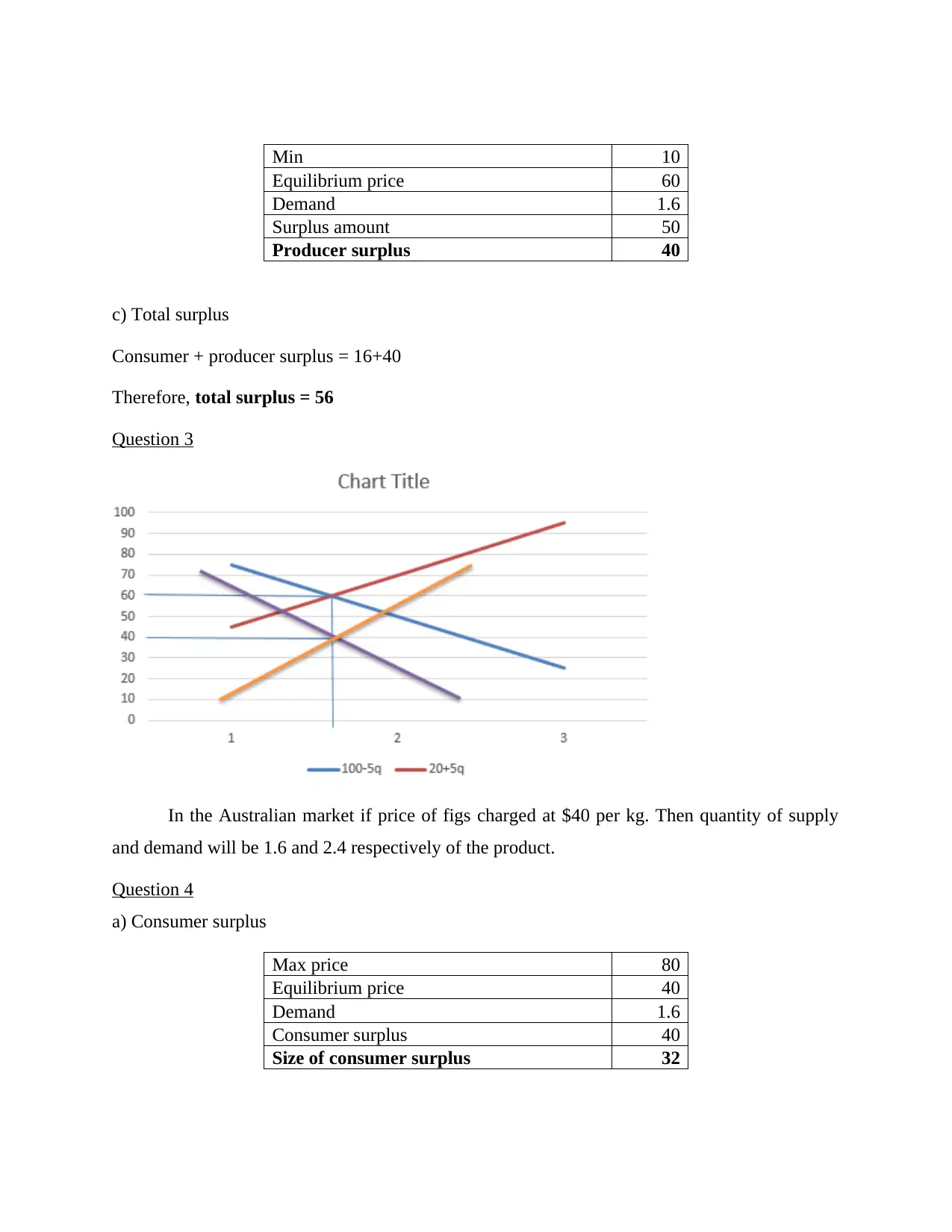
Min 10
Equilibrium price 60
Demand 1.6
Surplus amount 50
Producer surplus 40
c) Total surplus
Consumer + producer surplus = 16+40
Therefore, total surplus = 56
Question 3
In the Australian market if price of figs charged at $40 per kg. Then quantity of supply
and demand will be 1.6 and 2.4 respectively of the product.
Question 4
a) Consumer surplus
Max price 80
Equilibrium price 40
Demand 1.6
Consumer surplus 40
Size of consumer surplus 32
Equilibrium price 60
Demand 1.6
Surplus amount 50
Producer surplus 40
c) Total surplus
Consumer + producer surplus = 16+40
Therefore, total surplus = 56
Question 3
In the Australian market if price of figs charged at $40 per kg. Then quantity of supply
and demand will be 1.6 and 2.4 respectively of the product.
Question 4
a) Consumer surplus
Max price 80
Equilibrium price 40
Demand 1.6
Consumer surplus 40
Size of consumer surplus 32
Paraphrase This Document
Need a fresh take? Get an instant paraphrase of this document with our AI Paraphraser
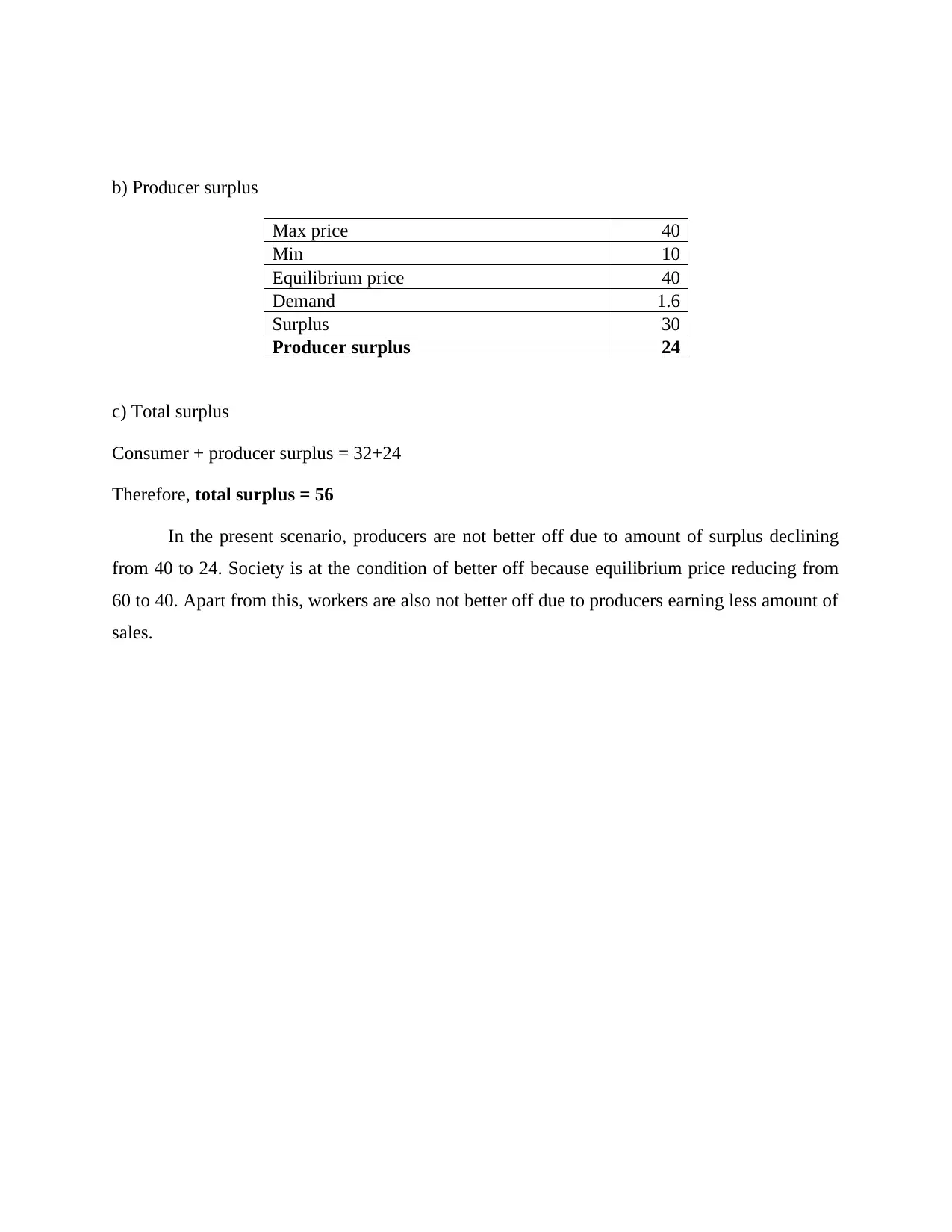
b) Producer surplus
Max price 40
Min 10
Equilibrium price 40
Demand 1.6
Surplus 30
Producer surplus 24
c) Total surplus
Consumer + producer surplus = 32+24
Therefore, total surplus = 56
In the present scenario, producers are not better off due to amount of surplus declining
from 40 to 24. Society is at the condition of better off because equilibrium price reducing from
60 to 40. Apart from this, workers are also not better off due to producers earning less amount of
sales.
Max price 40
Min 10
Equilibrium price 40
Demand 1.6
Surplus 30
Producer surplus 24
c) Total surplus
Consumer + producer surplus = 32+24
Therefore, total surplus = 56
In the present scenario, producers are not better off due to amount of surplus declining
from 40 to 24. Society is at the condition of better off because equilibrium price reducing from
60 to 40. Apart from this, workers are also not better off due to producers earning less amount of
sales.
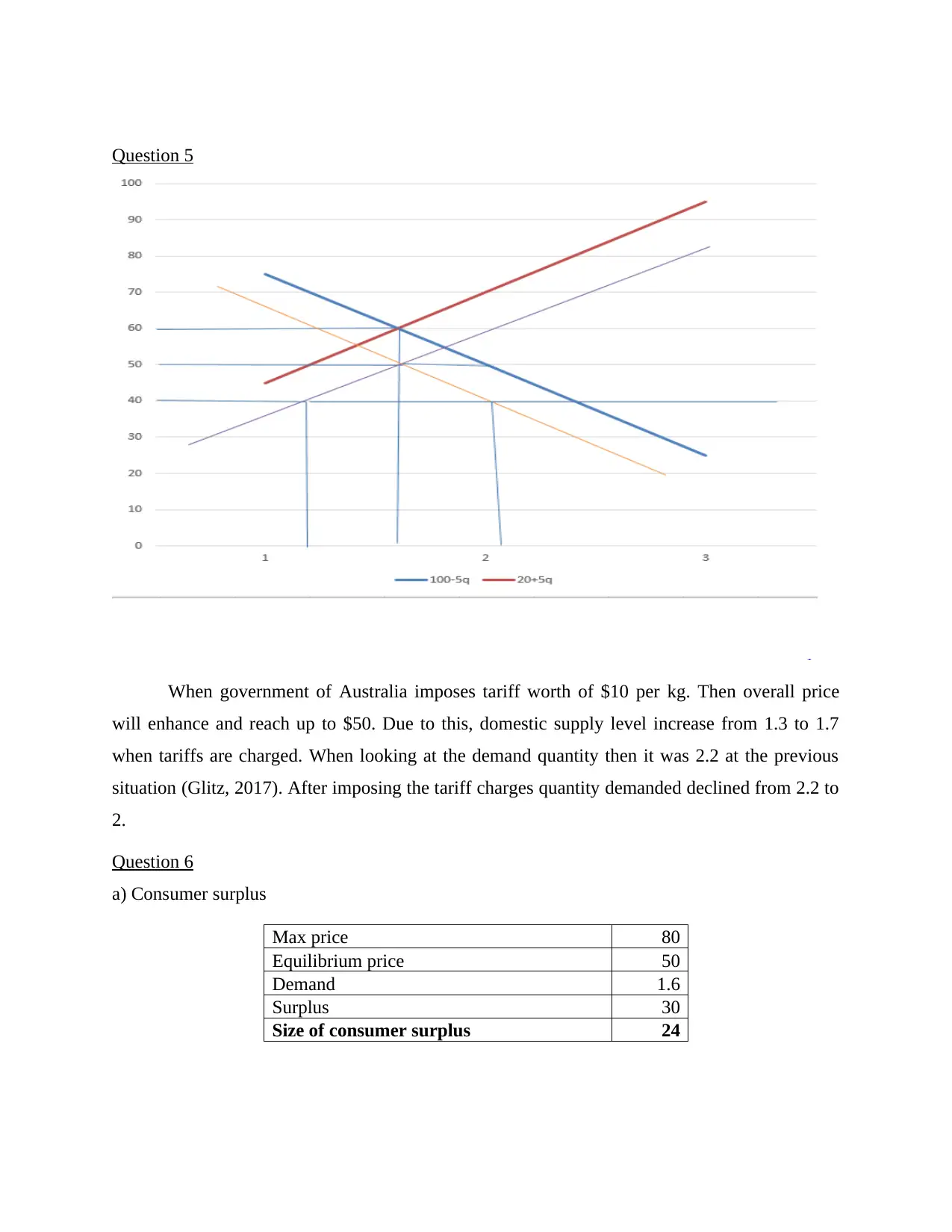
Question 5
When government of Australia imposes tariff worth of $10 per kg. Then overall price
will enhance and reach up to $50. Due to this, domestic supply level increase from 1.3 to 1.7
when tariffs are charged. When looking at the demand quantity then it was 2.2 at the previous
situation (Glitz, 2017). After imposing the tariff charges quantity demanded declined from 2.2 to
2.
Question 6
a) Consumer surplus
Max price 80
Equilibrium price 50
Demand 1.6
Surplus 30
Size of consumer surplus 24
When government of Australia imposes tariff worth of $10 per kg. Then overall price
will enhance and reach up to $50. Due to this, domestic supply level increase from 1.3 to 1.7
when tariffs are charged. When looking at the demand quantity then it was 2.2 at the previous
situation (Glitz, 2017). After imposing the tariff charges quantity demanded declined from 2.2 to
2.
Question 6
a) Consumer surplus
Max price 80
Equilibrium price 50
Demand 1.6
Surplus 30
Size of consumer surplus 24
⊘ This is a preview!⊘
Do you want full access?
Subscribe today to unlock all pages.

Trusted by 1+ million students worldwide
1 out of 15
Related Documents
Your All-in-One AI-Powered Toolkit for Academic Success.
+13062052269
info@desklib.com
Available 24*7 on WhatsApp / Email
![[object Object]](/_next/static/media/star-bottom.7253800d.svg)
Unlock your academic potential
Copyright © 2020–2025 A2Z Services. All Rights Reserved. Developed and managed by ZUCOL.





